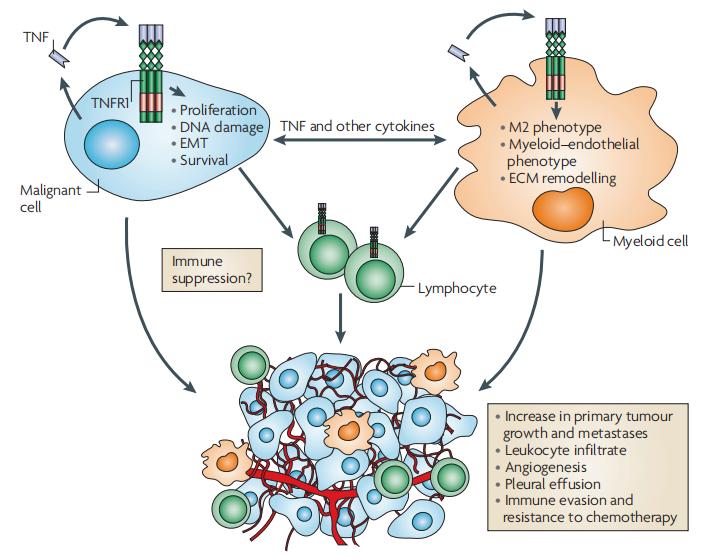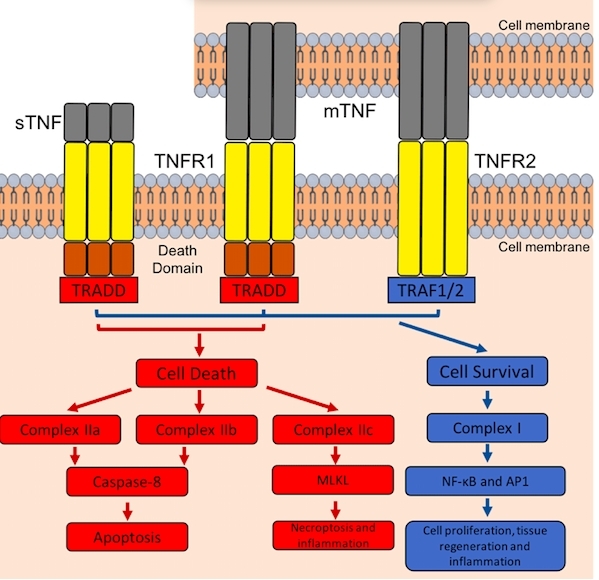Tumor Necrosis Factor (TNF) Production Measurement Service
Based on our advanced Cytokine Production Measurement Service and powerful technology, Creative Biolabs provides a complete range portfolio of assays for tumor necrosis factor (TNF) production services to meet our customers' different purposes. Our highly skilled scientists are ready to get started on your projects.
Introduction of Tumor Necrosis Factor
TNF is a central and pleiotropic cytokine in inflammatory reactions. TNF has both pro-inflammatory and anti-inflammatory effects on the development of cancers. Once an infection happens, the monocytes and macrophages will release the signal factor TNF to alert the nearby immune cells to take part in an inflammatory response. So the primary role of TNF is the regulation of immune cells. And they further have the ability to induce cell death and inhibit tumorigenesis.
However, dysregulation of TNF production homeostasis will elicit a variety of human diseases, including cancer. Fig.1 has shown the way TNF promotes cell transformation and tumor growth by increasing DNA damage, abnormal cell proliferation, tumor neovascularization, and immune evasion. Thus, it is very important to measure TNF production to monitor and study the immune effects of Engineered Cancer Cells with the self-destruction strategy.
 Fig.1 Pro-tumor actions of TNF in the tumor microenvironment. (Balkwill, 2009)
Fig.1 Pro-tumor actions of TNF in the tumor microenvironment. (Balkwill, 2009)
Classification and Mechanisms of TNF
The TNF superfamily contains a large group of type II transmembrane proteins, with 19 protein members binding to 29 members of the TNF receptor (TNFR) superfamily. The 26 kDa transmembrane protein (mTNF) will be released from the cell membrane after the cleavage of extracellular proteolytic enzyme and form the 17 kDa soluble TNF (sTNF), and then function as a bioactive cytokine.
TNF has been proven to modulate multiple signaling pathways, with wide-ranging downstream effects. As shown in Fig.2, TNF performs cellular functions mediated by its receptors: TNFR1 or TNFR2, and subsequently TNF promotes cell proliferation, programmed cell death, necrosis, inflammation, or tissue regeneration.
 Fig.2 Overview of TNF: TNFR1/2 signaling pathways. (Holbrook, et al., 2019)
Fig.2 Overview of TNF: TNFR1/2 signaling pathways. (Holbrook, et al., 2019)
TNF Production Measurement Services at Creative Biolabs
The production of TNF could be measured by methods including enzyme-linked immunoabsorbent assay (ELISA), flow cytometry (FC), western blot (WB), and biological assay methods.
ELISA is the most often employed tool to assess possible roles of TNF or other different cytokines in a specific process of disease or cancer. While traditional ELISA is practicable at Creative Biolabs, the Cytokine ELISA Plate Array, a chemiluminescence detection platform of Creative Biolabs is also available when you want to make clear the mechanism of multiple cytokines together. The fast and sensitive assay could monitor the abundance of 32 cytokines simultaneously by qualifying the quantity changes of these cytokines in different samples.
At the same time, Creative Biolabs is proficient in the FC assay allowing the measurement of TNF production by defined cell populations, which favors the study of definite functions and interactions of different cells. Western blot analysis with anti-TNF antibodies could have the TNF bands identified from a mixture of proteins from the samples. Through WB, Creative Biolabs will help you determine the existence of TNF in given samples. However, when you need to determine the activity of the TNF cytokine, Creative Biolabs also will help you with the biological assay for TNF production measurement.
Features of TNF Production Measurement Service
✔ Advanced technical platform with high sensitivity, accuracy, and repeatability
✔ Quantitative and qualitative project assessment
✔ Reliable lab report with timely update
With the in-depth study of TNF, Creative Biolabs offers advanced custom analytic service through the combined use of our software and multiplex analyzers. If you are interested in TNF production measurement service, please feel free to contact us directly.
References
-
Holbrook, J.; et al. Tumour necrosis factor signaling in health and disease. F1000Research. 2019, 8(111): 111.
-
Balkwill, F. Tumour necrosis factor and cancer. Nat Rev Cancer. 2009, 9: 361–371.
For Research Use Only | Not For Clinical Use


 Fig.1 Pro-tumor actions of TNF in the tumor microenvironment. (Balkwill, 2009)
Fig.1 Pro-tumor actions of TNF in the tumor microenvironment. (Balkwill, 2009)
 Fig.2 Overview of TNF: TNFR1/2 signaling pathways. (Holbrook, et al., 2019)
Fig.2 Overview of TNF: TNFR1/2 signaling pathways. (Holbrook, et al., 2019)
 Download our brochure
Download our brochure